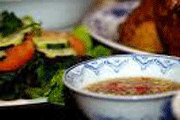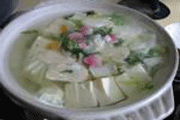 There are not very many dietary rules in Buddhism, but fasting or feasting on holidays is common. Buddhists believe in reincarnation, including the possibility of humans being reborn as animals and vice-versa. Consequently, they do not wish to harm living creatures, and many Buddhists are vegetarians. However, meat is not completely forbidden in Buddhist doctrines. Buddha advised monks that meat should be eaten only when the animal had not been specifically killed for consumption. Meat is eaten in small quantities in some Buddhist countries, where it may be obtained from Muslim butchers. Buddhists in Thailand, Myanmar, and Malaysia are more likely to eat meat than Buddhists in India. In maritime countries, fish and seafood are generally accepted as being valuable sources of protein; the issue of not killing animals is rationalized because the fish are not killed but merely removed from the water. Some Mahayana Buddhists in China and Vietnam also avoid eating strong-smelling plants such as onions, garlic, chives, shallots, and leeks, believing that the strong flavors of these vegetables may excite the senses and present a challenge to Buddhists seeking to control their desires. Rules are generally stricter for monks and nuns than for lay people. For example, monks may eat only twice a day-in the morning and at noon, fasting for the rest of the day and night. Lay people can gain merit for themselves and for their dead relatives by preparing food and offering it to the monks.
There are not very many dietary rules in Buddhism, but fasting or feasting on holidays is common. Buddhists believe in reincarnation, including the possibility of humans being reborn as animals and vice-versa. Consequently, they do not wish to harm living creatures, and many Buddhists are vegetarians. However, meat is not completely forbidden in Buddhist doctrines. Buddha advised monks that meat should be eaten only when the animal had not been specifically killed for consumption. Meat is eaten in small quantities in some Buddhist countries, where it may be obtained from Muslim butchers. Buddhists in Thailand, Myanmar, and Malaysia are more likely to eat meat than Buddhists in India. In maritime countries, fish and seafood are generally accepted as being valuable sources of protein; the issue of not killing animals is rationalized because the fish are not killed but merely removed from the water. Some Mahayana Buddhists in China and Vietnam also avoid eating strong-smelling plants such as onions, garlic, chives, shallots, and leeks, believing that the strong flavors of these vegetables may excite the senses and present a challenge to Buddhists seeking to control their desires. Rules are generally stricter for monks and nuns than for lay people. For example, monks may eat only twice a day-in the morning and at noon, fasting for the rest of the day and night. Lay people can gain merit for themselves and for their dead relatives by preparing food and offering it to the monks.
Southeast Asian recipes are prepared with ingredients cultivated in a wet, tropical climate. Many dishes are highly seasoned. Widely used basic ingredients include lemon grass, ginger, and a variety of fermented fish sauces or fish pastes. Fresh spices are ground when needed. Traditionally this was done with mortar and pestle, but today blenders or small electric grinders are quicker and more efficient. Unlike Western cooking, where ground spices are sprinkled into food, here they are cooked in a little fat over moderate heat to develop flavor. It is left to the cook to determine the amount of hot peppers in each dish! Zen cooking, developed by monks as a meditative art, focuses on achieving harmony, delicacy, and balance. Buddhist vegetarian chefs have become extremely creative in using gluten, tofu, agar, and other plant products. Soy and pressed wheat gluten (seitan or wheat-meat) are very versatile materials and can be manufactured into various shapes and textures. Although they have little flavoring of their own, with the proper seasonings these plant products can mimic various kinds of meat quite closely. Rice is a long-standing staple of the Japanese diet. Having strong symbolic value, rice is offered in prayer and praise to Shinto deities throughout Japan. Traditionally, it is boiled or steamed. In many Shinto ceremonies, pounded rice cakes called mochi (餅) are offered to the deities on behalf of the local community by the priest. Shintoism has no dietary restrictions.
 Since Buddhism has spread to many countries with diverse climates, traditions, and lifestyles, not all celebration days are universally recognized, nor is it surprising that Buddhist holiday food varies greatly. Calendars are based on a lunar or solilunar year; thus dates of celebrations may differ from country to country. While the traditional Japanese calendar dates from 660 BCE, the year of the accession to the throne of Emperor Jinmu, Japan’s legendary first emperor and descendent of the sun goddess Amaterasu, modern Japan uses the Gregorian solar calendar, the same as in the Western world. In Japan, there are two categories of holidays: Matsuri (祭り)are festivals, mainly of Shinto origin, that relate to the cultivation of rice and the spiritual well-being of the community. Nencho gyo are annual events of Chinese or Buddhist origin.
Since Buddhism has spread to many countries with diverse climates, traditions, and lifestyles, not all celebration days are universally recognized, nor is it surprising that Buddhist holiday food varies greatly. Calendars are based on a lunar or solilunar year; thus dates of celebrations may differ from country to country. While the traditional Japanese calendar dates from 660 BCE, the year of the accession to the throne of Emperor Jinmu, Japan’s legendary first emperor and descendent of the sun goddess Amaterasu, modern Japan uses the Gregorian solar calendar, the same as in the Western world. In Japan, there are two categories of holidays: Matsuri (祭り)are festivals, mainly of Shinto origin, that relate to the cultivation of rice and the spiritual well-being of the community. Nencho gyo are annual events of Chinese or Buddhist origin.
This article is originating from http://hubpages.com




